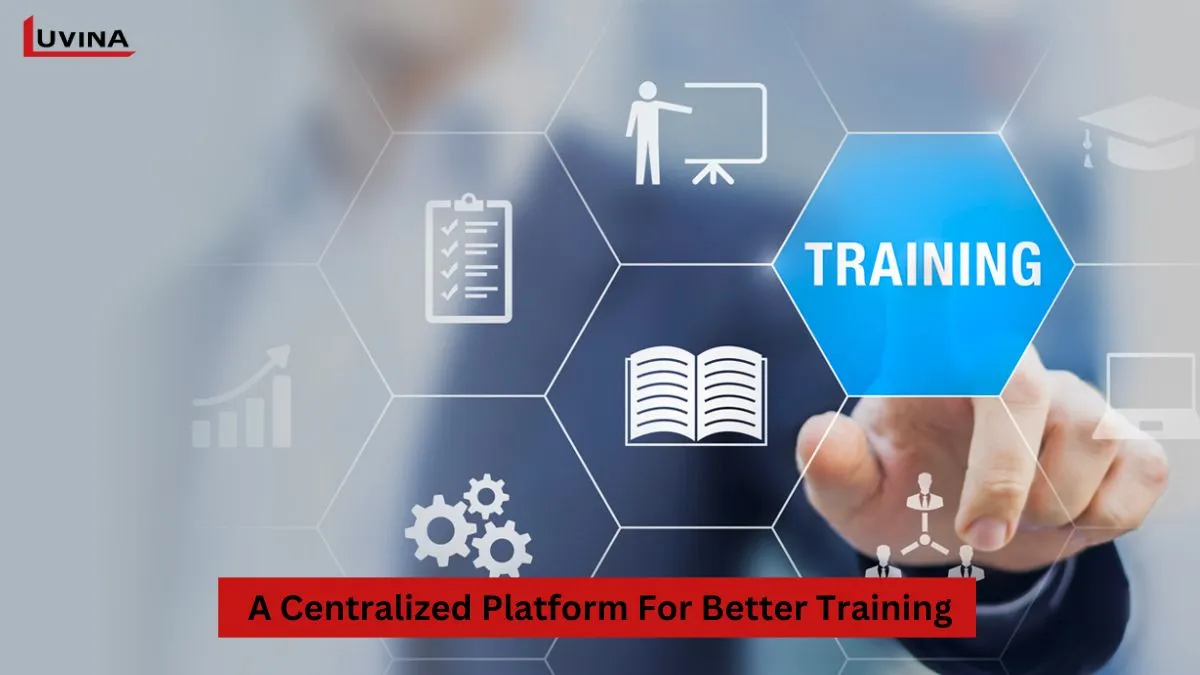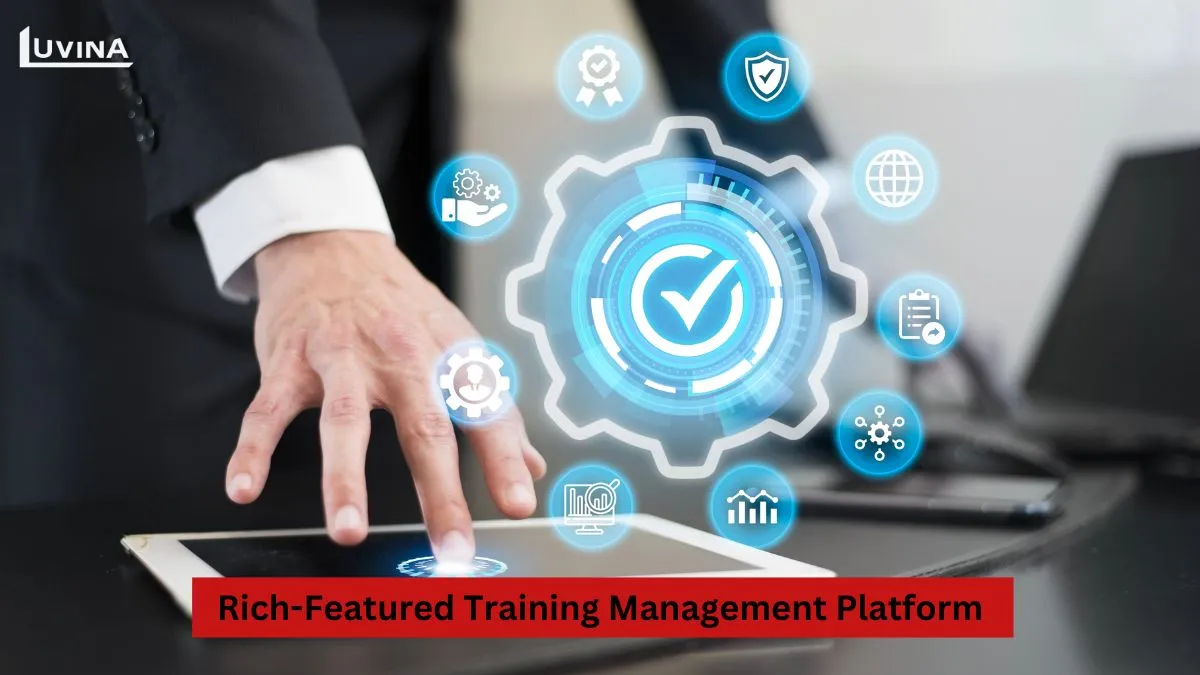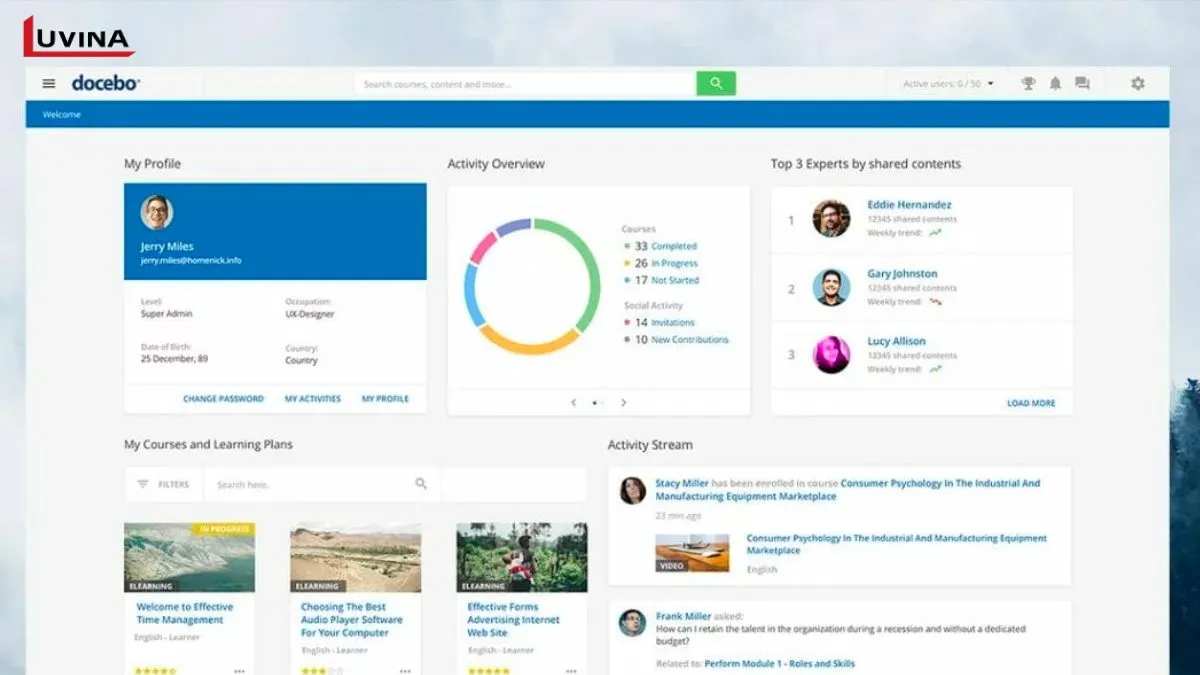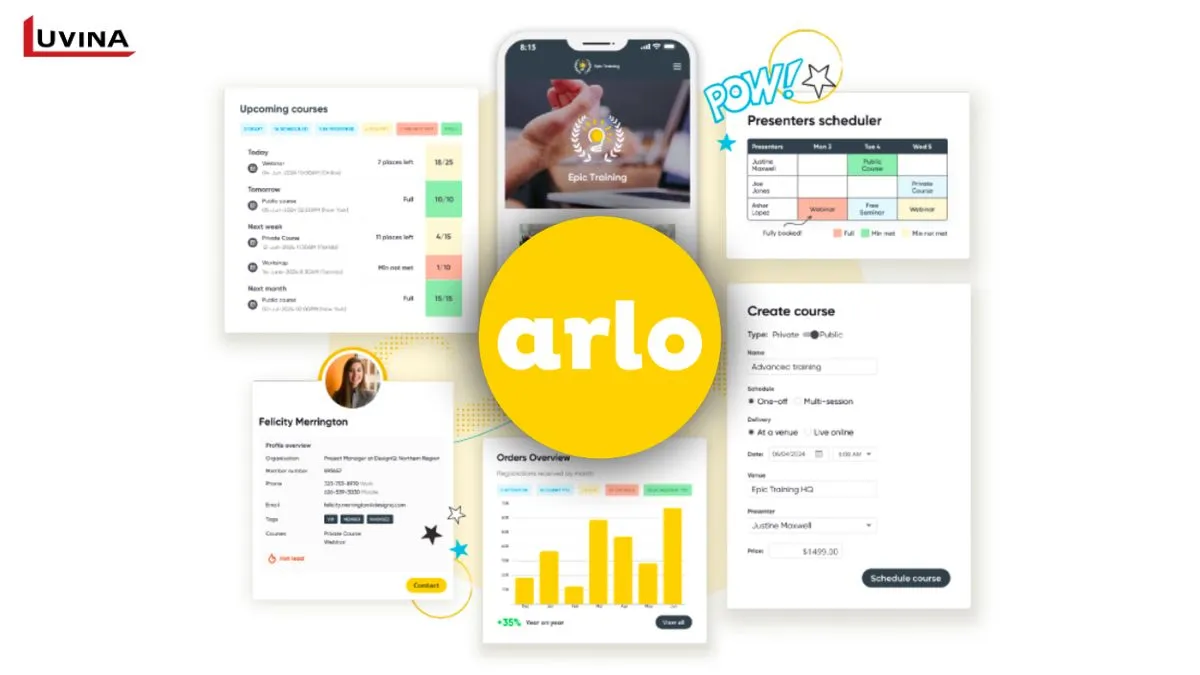Did you know 76% of employees are more likely to stay with a company that offers structured training? In today’s fast-paced business world, an effective training management system (TMS) is no longer optional—it’s a necessity for workforce development and retention. The right system enhances engagement, tracks progress, and ensures structured learning experiences. In this article, we discuss the major features of a contemporary training management system, its advantages, the distinction between a learning management system and a training management system, and the best solutions in 2025 to automate your training process.
What is a training management system?
A training management system is a centralized platform that helps organizations efficiently plan, organize, and oversee their training programs. It streamlines must-have procedures like course scheduling, participant registration, and logistics management—all of which reduce manual workload and improve operational efficiency—and offers the possible tracking of payments, monitoring of learner progress, and management of general overall training performance in one unified platform.

In contrast to the use of separate stand-alone tools, training record management software combines multiple functions into one system, both improving learning results and business expansion. Training record management software enables organizations to keep thorough training histories, monitor compliance, and ensure employees attain necessary certifications. By streamlining these essential processes, organizations can concentrate on providing quality training while maximizing resources and lowering administrative expenses.
Key features of a TMS
A beautifully crafted training management platform enables companies to efficiently create, control, and expand training plans. These tools improve learning results and help training operations run more efficiently, from automatic handling of administrative tasks to tracking student activity. Among the few main qualities to think of in the choice of the perfect system are these:
- Course creation & management: A robust platform allows organizations to create, calendar, and monitor different forms of training programs, including instructor-led, virtual, and blended learning. With built-in templates and integration with learning management systems (LMS), trainers can easily develop course materials, assign instructors, and oversee session logistics.
- Automated workflows: Manual administrative tasks such as enrollment, attendance tracking, and progress monitoring are automated, reducing workload and ensuring accurate record-keeping.
- Learner management: A training information management system captures and stores learner data, links it to specific courses and automates notifications for registrations, reminders, and follow-ups.
- Gamification & Engagement: Integrating gamification elements into a training management system boosts learner engagement and motivation. Features like badges, points, and leaderboards create a sense of achievement and introduce healthy competition. This not only encourages participation but also helps organizations track progress more effectively.
- Reporting & data analytics: A complete training information management system would deliver real-time reporting on key training metrics such as learner performance, course effectiveness, and revenue earned. Using customizable dashboards and AI-driven reporting features, organizations can make data-informed choices to enhance their training programs.
- Learning Path & Certification Tracking: A robust system should allow for structured learning paths, ensuring employees complete required training in a specific order. Certification tracking is equally crucial, enabling automatic certificate issuance and renewal reminders. This feature ensures compliance with industry standards while keeping employees up to date with necessary skills.
- Automated Notifications & Reminders: Automated notifications act as training assistants, sending timely reminders to learners about upcoming courses, deadlines, or certifications that need renewal. These notifications can be integrated with email, Slack, or MS Teams, ensuring seamless communication and improving course completion rates.

Benefits of TMS
There are several advantages to having a training management system, including the ability to automate training procedures, improve the learning experience, and, in general, increase overall efficiency.
- Automating administrative tasks & saving time: A TMS does away with the need for such a time-consuming task as sending reminder emails, handling invoices, and tracking attendance. By allowing organizations to automate such activities, they save a tremendous amount of administrative effort, thus making it possible for managers and trainers to focus on learner interactions and course material.
- Enhancing training quality & knowledge retention: With structured training workflows and integrated analytics, a training system management platform helps organizations refine course content based on learner progress and feedback. Interactive learning materials and personalized learning paths contribute to better knowledge retention and skill development.
- Improving scalability & business growth: By facilitating businesses to offer more training courses and enroll more students without additional administrative inconvenience, a TMS facilitates business expansion and scalability. It also allows scalability. Computerized course scheduling, resource management, and cost monitoring tools at one’s disposal enable training businesses to expand operations without a hitch.
- Centralizing training data & performance tracking: Having all the training-related information on one platform, a TMS provides real-time visibility into learner progress, course effectiveness, and overall training performance. Robust reporting capabilities help organizations monitor ROI and design future training with the best strategies.
- Enhancing learner experience & engagement: An efficiently arranged TMS gives a continuous learning experience with open access to training materials, automation of learner communication, and instant course alerts, therefore improving student experience and engagement. This informs pupils nonstop, raises engagement, and improves training effectiveness.
Key difference between learning management systems and training management systems
Although both are applied to training programs, the uses are different. While a learning management system is concerned with course delivery and monitoring learner progression, a training management system (TMS) is designed to schedule and control training administration.
The main aspects of each system are here contrasted:
| Feature | Training Management System (TMS) | Learning Management System (LMS) |
| Primary focus | Organizing and managing training logistics | Delivering training content and tracking learner progress |
| Main users | HR and Learning & Development teams, training coordinators | Learners, instructors, and educational facilitators |
| Type of content | Training sessions, workshops, certifications, and compliance materials | eLearning courses, quizzes, and assessments |
| Automation features | Automates scheduling, participant registration, and attendance tracking | Automates course enrollment, progress tracking, and completion certifications |
By understanding such distinctions, organizations can determine whether a training management system or a training content management system is most suitable for their organization.
Top 5 best training management systems
When choosing the best training management software for your business, it’s important to review solutions not just automating the planning and distribution of training programs but also improving efficiency and scalability. What follows are 5 of the top-rated platforms (training tracking software, free and paid) most significant for having an array of comprehensive features and functionality, which allows businesses to optimize their training management process.
| System | Key features | Pros | Cons | Best suited for | Pricing |
| iSpring Learn | Spring Suite course creator and editor Learning track developmentAutomatic course assignments and filters Events Calendar for live training, workshops, and meetings Learner portal with gamification features like points, badges, and leaderboards | User-friendly interfaceStrong reporting and performance appraisal features Ideal for specific training types such as compliance, job-specific training, and product training | Limited interface customization optionsFeature set not as expansive as other platforms | Companies looking for easy-to-use training record management software for onboarding, compliance, and role-specific training | Starts at $2.29 per user per month (for the Start plan with 300 users) |
| Docebo | Generative AI-powered tools for enhanced content delivery and customization Integration with various business applications and eLearning platforms Learning management and content creation, including multimedia and translationsMobile learning support with the ability to create a personalized learning app Built-in reporting for performance analysis, surveys, and questionnaires | Strong customer support and an intuitive user interface Over 400 integrations with other platforms and business tools Comprehensive eCommerce and gamification features | Pricing details are only available upon request, which may limit transparency | Organizations looking for a scalable, customizable system for upskilling, employee training, and continuous learning across various departments | Available upon request |
| Talent LMS | Task automation for course grading and assignmentGamification tools, including points, badges, and leaderboardsCustomizable dashboards and reports for tracking progress Built-in videoconferencing for hybrid or online learning Support for SCORM, xAPI, and cmi5 file uploads | User-friendly interface with an easy-to-navigate design Flexible and customizable with multiple integration optionsUnlimited email support with the Starter Plan | Automated course assignment and user management only available with the Premium Plan | Large organizations | Free plan available Starter Plan: $89/month (up to 40 users)Premium Plan: $569/month (up to 1,000 users) |
| Moodle | Customizable learning paths for individuals or groupsMobile app for learning on the go Integration of multimedia content for a rich learning experience Support for multiple assessment and grading options Over 100 language supports | Open-source and customizable to meet specific needsExtensive community of developers for system improvements Suitable for both blended and online learning | Requires installation and configuration, which may require external help More suitable for educational institutions than businesses | Educational institutions ranging from K-12 to higher education Organizations looking for a customizable, open-source solution for online and blended learning | Starter: $130.00 per year Mini: $220.00 per year Smal: $400.00 per year Medium: $910.00 per year |
| Arlo | Automated course scheduling and templates Customizable registration forms and course applications Commerce features for easy payment processing Integration with tools like Zoom, WordPress, Salesforce, and XeroSupports various learning formats: instructor-led, web-based, and self-paced | Strong integrations with popular tools like Zoom and SalesforceStreamlined registration and payment process Customizable features to suit different training needs | Advanced features like certificates and customer portal are available only with higher-tier plans | Organizations that offer a variety of training formats and require an integrated, streamlined system for course administration and payments | Simple Plan: £74 per month (billed annually)Professional Plan: £131 per month Enterprise Plan: £176 per month |
1. iSpring Learn
iSpring Learn is a robust training management platform meant for both students and administrators. It contains strong features, from course authoring tools to the creation of learning paths and automatic assignments, and thus it is an excellent choice for businesses to manage training in an organized manner. Utilizing gamification elements, such as points, badges, and leaderboards within iSpring Learn offers an intriguing learning experience. Additionally, its analytics and reporting capabilities provide profound insight into learner development and training effects, making it easier to streamline training programs.
2. Docebo
Made to simplify the process of learning and development in any-sized organization, Docebo is an end-to-end cloud-based solution. With automation software, custom learning experiences, and scalability for globally distributed teams, it offers a myriad of features committed to simplifying training management and delivery.
Organizations that are planning to involve their employees, as well as customers, in continuous learning programs, will find Docebo’s artificial intelligence-powered functionality and eCommerce integrations an ultimate choice. The platform enables mobile learning and multimedia content as well as smooth integration with many other commercial applications.

3. Talent LMS
TalentLMS is a highly intuitive free training management system designed to simplify and enhance the learning experience. This platform offers a wide range of features, including gamification, communication tools, and blended learning options, to engage learners while also providing administrative efficiency.
TalentLMS allows effortless growth of training programs and streamlines onboarding functions, with the inclusion of integrated user administration, tracking features, and multi-phase learning path configuration. Further, it is endowed with integrated videoconferencing capabilities, enabling online or combined learning sessions.
4. Moodle
Moodle is a free, open-source training management platform that provides a flexible solution for both blended and online learning environments. It is designed to serve schools, from K-12 up to the university level. It is a highly customizable platform, and institutions can tailor the system to their needs.
Moodle offers a range of features to track learners’ progress, integrate rich multimedia content, and provide diverse assessment and grade systems. Its mobile app allows learners to continue learning even when they are not in one place. Even though Moodle is open-source, it is being continuously improved by a vast number of developers.
5. Arlo Traning Management Software
Arlo offers a robust training management system designed to simplify and optimize the entire process of managing and delivering training programs. With its intuitive tools, Arlo helps organizations efficiently schedule, register, and administer training courses. The platform allows flexibility in the type of training delivered, whether it’s instructor-led, self-paced, or web-based.
Additionally, Arlo features eCommerce capabilities for easy online payments and integrates seamlessly with popular platforms like PayPal, Zoom, and Salesforce, making it an ideal choice for businesses looking to streamline their training operations.

How can Luvina help?
Luvina is the trusted partner for developing a training system management solution that is both reliable and customized to your organization’s specific needs. With years of experience and a proven track record, our team excels in creating training management systems that address the unique challenges and goals of each business. We understand that every enterprise has its own learning objectives, and we are committed to designing solutions that meet those requirements effectively.
As an established software development company, we offer scalable and flexible learning management services that are built to grow alongside your business. Whether adapting an existing system or building a new one from scratch, we leverage the latest technologies and methodologies to ensure the solution is secure, robust, and user-friendly.
From the initial consultation to full deployment and ongoing support, our dedicated experts collaborate closely with you to make sure your training system aligns with your business goals, optimizes training outcomes, and prepares you for future success.
Conclusion
In conclusion, a training system management solution can revolutionize how businesses plan, deliver, and scale their training programs. With its powerful features like automated scheduling, CRM integration, and data analytics, a TMS ensures a smooth experience for both administrators and learners, while helping organizations streamline operations and reduce costs.
If you are still relying on outdated methods like spreadsheets or manual billing, it may be time to consider implementing a TMS. With the right system, you can energize your learning journey, enhance employee engagement, and drive productivity.
Related Posts:









Read More From Us?
Sign up for our newsletter
Read More From Us?
Sign up for our newsletter